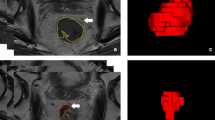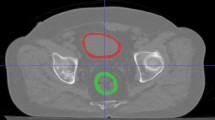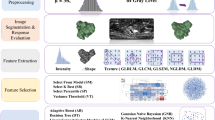Abstract
Background
Rectal toxicity is one of the common side effects after radiotherapy in prostate cancer patients. Radiomics is a non-invasive and low-cost method for developing models of predicting radiation toxicity that does not have the limitations of previous methods. These models have been developed using individual patients’ information and have reliable and acceptable performance. This study was conducted by evaluating the radiomic features of computed tomography (CT) and magnetic resonance (MR) images and using machine learning (ML) methods to predict radiation-induced rectal toxicity.
Methods
Seventy men with pathologically confirmed prostate cancer, eligible for three-dimensional radiation therapy (3DCRT) participated in this prospective trial. Rectal wall CT and MR images were used to extract first-order, shape-based, and textural features. The least absolute shrinkage and selection operator (LASSO) was used for feature selection. Classifiers such as Random Forest (RF), Decision Tree (DT), Logistic Regression (LR), and K-Nearest Neighbors (KNN) were used to create models based on radiomic, dosimetric, and clinical data alone or in combination. The area under the curve (AUC) of the receiver operating characteristic curve (ROC), accuracy, sensitivity, and specificity were used to assess each model’s performance.
Results
The best outcomes were achieved by the radiomic features of MR images in conjunction with clinical and dosimetric data, with a mean of AUC: 0.79, accuracy: 77.75%, specificity: 82.15%, and sensitivity: 67%.
Conclusions
This research showed that as radiomic signatures for predicting radiation-induced rectal toxicity, MR images outperform CT images.





Similar content being viewed by others
Data Availability
In the present study, the datasets are in the possession of the corresponding author and can be accessed if needed.
References
Dearnaley DP, Jovic G, Syndikus I, Khoo V, Cowan RA, Graham JD et al (2014) Escalated-dose versus control-dose conformal radiotherapy for prostate cancer: long-term results from the MRC RT01 randomised controlled trial. Lancet Oncol 15(4):464–473
Kuban DA, Tucker SL, Dong L, Starkschall G, Huang EH, Cheung MR et al (2008) Long-term results of the MD Anderson randomized dose-escalation trial for prostate cancer. Int J Radiat Oncol Biol Phys 70(1):67–74
Su AW, Jani AB (2007) Chronic genitourinary and gastrointestinal toxicity of prostate cancer patients undergoing pelvic radiotherapy with intensity-modulated versus 4-field technique. Am J Clin Oncol 30(3):215–219
Shu H-KG, Lee TT, Vigneault E, Xia P, Pickett B, Phillips TL et al (2001) Toxicity following high-dose three-dimensional conformal and intensity-modulated radiation therapy for clinically localized prostate cancer. Urology 57(1):102–107
Zelefsky MJ, Levin EJ, Hunt M, Yamada Y, Shippy AM, Jackson A et al (2008) Incidence of late rectal and urinary toxicities after three-dimensional conformal radiotherapy and intensity-modulated radiotherapy for localized prostate cancer. Int J Radiat Oncol Biol Phys 70(4):1124–1129
Hoffman KE, Voong KR, Pugh TJ, Skinner H, Levy LB, Takiar V et al (2014) Risk of late toxicity in men receiving dose-escalated hypofractionated intensity modulated prostate radiation therapy: results from a randomized trial. Int J Radiat Oncol Biol Phys 88(5):1074–1084
D’Avino V, Palma G, Liuzzi R, Conson M, Doria F, Salvatore M et al (2015) Prediction of gastrointestinal toxicity after external beam radiotherapy for localized prostate cancer. Radiat Oncol 10(1):1–9
Schaake W, van der Schaaf A, van Dijk LV, Bongaerts AHH, van den Bergh ACM, Langendijk JA (2016) Normal tissue complication probability (NTCP) models for late rectal bleeding, stool frequency and fecal incontinence after radiotherapy in prostate cancer patients. Radiother Oncol 119(3):381–387
Yeoh EK, Krol R, Dhillon VS, Botten R, Di Matteo A, Butters J et al (2016) Predictors of radiation-induced gastrointestinal morbidity: a prospective, longitudinal study following radiotherapy for carcinoma of the prostate. Acta Oncol (Madr) 55(5):604–610
Michalski JM, Gay H, Jackson A, Tucker SL, Deasy JO (2010) Radiation dose–volume effects in radiation-induced rectal injury. Int J Radiat Oncol Biol Phys 76(3):S123–S129
Thor M, Olsson C, Oh JH, Petersen SE, Alsadius D, Bentzen L et al (2016) Urinary bladder dose–response relationships for patient-reported genitourinary morbidity domains following prostate cancer radiotherapy. Radiother Oncol 119(1):117–122
El Naqa I, Johansson A, Owen D, Cuneo K, Cao Y, Matuszak M et al (2018) Modeling of normal tissue complications using imaging and biomarkers after radiation therapy for hepatocellular carcinoma. Int J Radiat Oncol Biol Phys 100(2):335–343
Van Dijk LV, Brouwer CL, Van Der Schaaf A, Burgerhof JGM, Beukinga RJ, Langendijk JA et al (2017) CT image biomarkers to improve patient-specific prediction of radiation-induced xerostomia and sticky saliva. Radiother Oncol 122(2):185–191
Arimura H, Soufi M, Kamezawa H, Ninomiya K, Yamada M (2019) Radiomics with artificial intelligence for precision medicine in radiation therapy. J Radiat Res 60(1):150–157
Bhosale YH, Patnaik KS (2022) Application of deep learning techniques in diagnosis of covid-19 (coronavirus): a systematic review.Neural Process Lett. ;1–53
Aerts HJWL, Velazquez ER, Leijenaar RTH, Parmar C, Grossmann P, Carvalho S et al (2014) Decoding tumour phenotype by noninvasive imaging using a quantitative radiomics approach. Nat Commun 5(1):1–9
Guiot J, Vaidyanathan A, Deprez L, Zerka F, Danthine D, Frix A et al (2022) A review in radiomics: making personalized medicine a reality via routine imaging. Med Res Rev 42(1):426–440
Spohn SKB, Bettermann AS, Bamberg F, Benndorf M, Mix M, Nicolay NH et al (2021) Radiomics in prostate cancer imaging for a personalized treatment approach-current aspects of methodology and a systematic review on validated studies. Theranostics 11(16):8027
Ren J, Tian J, Yuan Y, Dong D, Li X, Shi Y et al (2018) Magnetic resonance imaging based radiomics signature for the preoperative discrimination of stage I-II and III-IV head and neck squamous cell carcinoma. Eur J Radiol 106:1–6
Kniep HC, Madesta F, Schneider T, Hanning U, Schönfeld MH, Schön G et al (2019) Radiomics of brain MRI: utility in prediction of metastatic tumor type. Radiology 290(2):479–487
Peeken JC, Bernhofer M, Spraker MB, Pfeiffer D, Devecka M, Thamer A et al (2019) CT-based radiomic features predict tumor grading and have prognostic value in patients with soft tissue sarcomas treated with neoadjuvant radiation therapy. Radiother Oncol 135:187–196
Bogowicz M, Jochems A, Deist TM, Tanadini-Lang S, Huang SH, Chan B et al (2020) Privacy-preserving distributed learning of radiomics to predict overall survival and HPV status in head and neck cancer. Sci Rep 10(1):1–10
Krarup MMK, Nygård L, Vogelius IR, Andersen FL, Cook G, Goh V et al (2020) Heterogeneity in tumours: validating the use of radiomic features on 18F-FDG PET/CT scans of lung cancer patients as a prognostic tool. Radiother Oncol 144:72–78
Gardin I, Grégoire V, Gibon D, Kirisli H, Pasquier D, Thariat J et al (2019) Radiomics: principles and radiotherapy applications. Crit Rev Oncol Hematol 138:44–50
Bulens P, Couwenberg A, Intven M, Debucquoy A, Vandecaveye V, Van Cutsem E et al (2020) Predicting the tumor response to chemoradiotherapy for rectal cancer: model development and external validation using MRI radiomics. Radiother Oncol 142:246–252
Cao Q, Li Y, Li Z, An D, Li B, Lin Q (2020) Development and validation of a radiomics signature on differentially expressed features of 18F-FDG PET to predict treatment response of concurrent chemoradiotherapy in thoracic esophagus squamous cell carcinoma. Radiother Oncol 146:9–15
Abdollahi H, Mahdavi SR, Mofid B, Bakhshandeh M, Razzaghdoust A, Saadipoor A et al (2018) Rectal wall MRI radiomics in prostate cancer patients: prediction of and correlation with early rectal toxicity. Int J Radiat Biol 94(9):829–837
Mostafaei S, Abdollahi H, Kazempour Dehkordi S, Shiri I, Razzaghdoust A, Zoljalali Moghaddam SH et al (2020) CT imaging markers to improve radiation toxicity prediction in prostate cancer radiotherapy by stacking regression algorithm. Radiol Med 125(1):87–97
Abdollahi H, Tanha K, Mofid B, Razzaghdoust A, Saadipoor A, Khalafi L et al (2019) MRI radiomic analysis of IMRT-induced bladder wall changes in prostate cancer patients: a relationship with radiation dose and toxicity. J Med Imaging Radiat Sci 50(2):252–260
Moran A, Daly ME, Yip SSF, Yamamoto T (2017) Radiomics-based assessment of radiation-induced lung injury after stereotactic body radiotherapy. Clin Lung Cancer 18(6):e425–e431
Abdollahi H, Mostafaei S, Cheraghi S, Shiri I, Mahdavi SR, Kazemnejad A (2018) Cochlea CT radiomics predicts chemoradiotherapy induced sensorineural hearing loss in head and neck cancer patients: a machine learning and multi-variable modelling study. Phys Med 45:192–197
Fawcett T (2006) An introduction to ROC analysis. Pattern Recognit Lett 27(8):861–874
Peisen F, Hänsch A, Hering A, Brendlin AS, Afat S, Nikolaou K et al (2022) Combination of whole-body baseline CT Radiomics and Clinical Parameters to predict response and survival in a Stage-IV Melanoma Cohort Undergoing Immunotherapy. Cancers (Basel) 14(12):2992
Liu J, Tang J, Xia B, Gu Z, Yin H, Zhang H et al (2022) Novel Radiomics-Clinical Model for the Noninvasive Prediction of New Fractures After Vertebral Augmentation. Acad Radiol.
Yang Q, Sun J, Guo Y, Zeng P, Jin K, Huang C et al (2022) Radiomics features on computed tomography combined with clinical-radiological factors Predicting Progressive Hemorrhage of Cerebral Contusion.Front Neurol. ; 13
Amiri S, Akbarabadi M, Abdolali F, Nikoofar A, Esfahani AJ, Cheraghi S (2021) Radiomics analysis on CT images for prediction of radiation-induced kidney damage by machine learning models. Comput Biol Med 133:104409
Du F, Tang N, Cui Y, Wang W, Zhang Y, Li Z et al (2020) A novel nomogram model based on cone-beam CT radiomics analysis technology for predicting radiation pneumonitis in esophageal cancer patients undergoing radiotherapy. Front Oncol 10:596013
Wang J, Shen L, Zhong H, Zhou Z, Hu P, Gan J et al (2019) Radiomics features on radiotherapy treatment planning CT can predict patient survival in locally advanced rectal cancer patients. Sci Rep 9(1):1–9
Acknowledgements
The authors are appreciative of the cooperation of Isfahan Milad Hospital for data collection.
Funding
This article was conducted with the financial support of the Isfahan University of Medical Sciences, Isfahan, I.R. Iran (grant number 399646).
Author information
Authors and Affiliations
Contributions
All authors contributed to the study conception and design. Data curation was performed by Hossein Hassaninejad, Hamid Abdollahi, Iraj Abedi and Alireza Amouheidari. Methodology, formal analysis and investigation were performed by Hossein Hassaninejad and Hamid Abdollahi. Software was performed by Hossein Hassaninejad. Funding acquisition, supervision, project administration was performed by Mohamad Bagher Tavakoli. Writing – Original Draft Preparation were performed by All authors. Writing – Review & Editing were performed by Hossein Hassaninejad, Hamid Abdollahi, Iraj Abedi and Mohamad Bagher Tavakoli.
Corresponding author
Ethics declarations
Conflict of interest
This article has no conflict of interest and this issue is approved by the authors.
Ethics approval
This investigation was following the Helsinki Declaration. This prospective research was carried out with the agreement of the local ethics committee (Isfahan University of Medical Sciences, Isfahan, Iran, IR.MUI.MED.REC.1399.731).
Consent to participate
Informed consent was obtained from all individual participants included in the study.
Additional information
Publisher’s Note
Springer Nature remains neutral with regard to jurisdictional claims in published maps and institutional affiliations.
Rights and permissions
Springer Nature or its licensor (e.g. a society or other partner) holds exclusive rights to this article under a publishing agreement with the author(s) or other rightsholder(s); author self-archiving of the accepted manuscript version of this article is solely governed by the terms of such publishing agreement and applicable law.
About this article
Cite this article
Hassaninejad, H., Abdollahi, H., Abedi, I. et al. Radiomics based predictive modeling of rectal toxicity in prostate cancer patients undergoing radiotherapy: CT and MRI comparison. Phys Eng Sci Med 46, 1353–1363 (2023). https://doi.org/10.1007/s13246-023-01260-5
Received:
Accepted:
Published:
Issue Date:
DOI: https://doi.org/10.1007/s13246-023-01260-5




